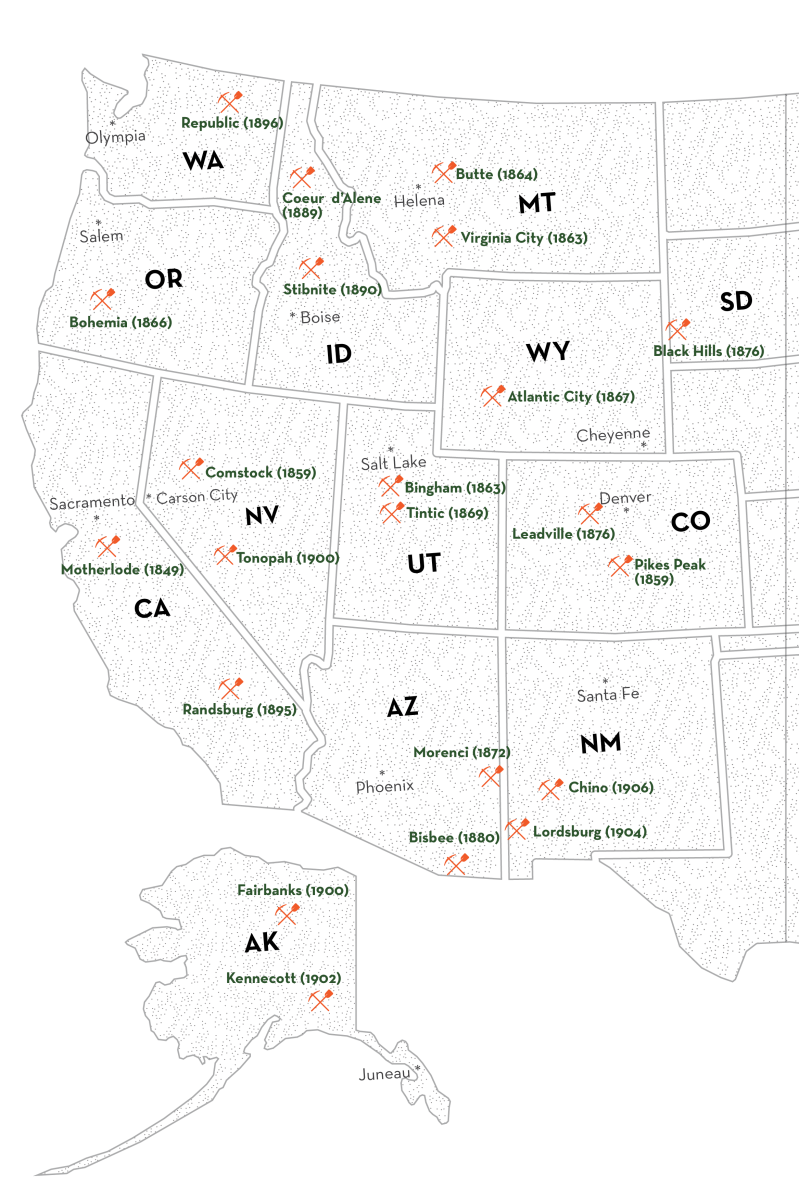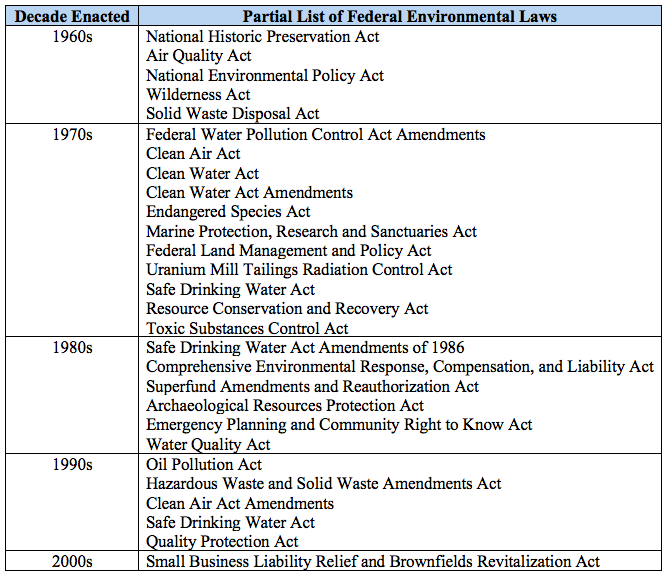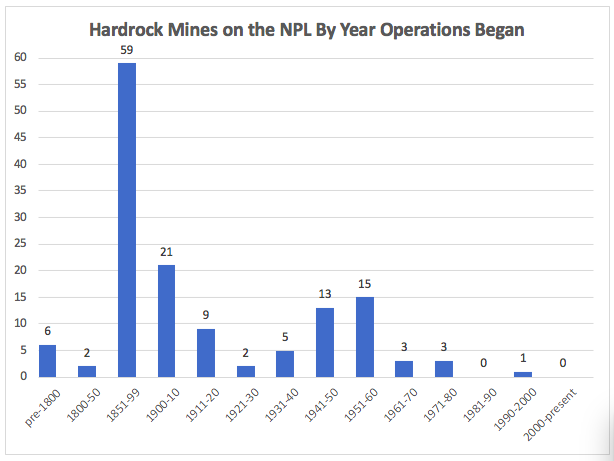Published on September 18, 2020
 The following is a guest blog written by Debra Struhsacker. Debra is a hardrock mining policy expert with over 30 years of hands-on expertise with environmental and public land laws and regulations pertaining to mineral exploration and mine development. She is one of the founders of the Women’s Mining Coalition and currently serves on the Coalition’s Board of Directors. Debra is a Certified Professional Geologist with the American Institute of Professional Geologists.
The following is a guest blog written by Debra Struhsacker. Debra is a hardrock mining policy expert with over 30 years of hands-on expertise with environmental and public land laws and regulations pertaining to mineral exploration and mine development. She is one of the founders of the Women’s Mining Coalition and currently serves on the Coalition’s Board of Directors. Debra is a Certified Professional Geologist with the American Institute of Professional Geologists.
Modern Environmental Laws Ensure Today’s Mines Protect the Environment
Mining opponents are stuck in the past when they claim “mines always pollute…miners always repeat the mistakes of the past…you just can’t find a good example of a mine.” They are conjuring up images of antiquated and unregulated mining practices from decades ago to obscure the truth about today’s highly regulated mines. They look backwards to a bygone era when there were no environmental protection regulations for mining (or other industries) to foment concern and recruit opposition to proposed modern mining projects.
But times have changed dramatically for today’s mines, as well as for other industries. Modern mines, manufacturing facilities, and industrial projects must comply with many stringent and comprehensive state and federal environmental protection laws and regulations. These laws and regulations require modern mines to be designed, built, and operated with numerous safeguards to protect the environment. Plus – unlike other industries – miners must reclaim the land when mining is completed and provide state and federal regulators with reclamation bonds to guarantee the mine will be properly reclaimed. The bond amount is calculated on the basis that the government has to reclaim the mine.
Just ask the U.S. Environmental Protection Agency (EPA). In 2018, EPA issued a final rulemaking for Section 108(b) ofthe Comprehensive Environmental Response, Compensation, and Liability Act (CERCLA), commonly called the “Superfund,” that determined EPA did not need to develop a separate financial assurance program for the hardrock (metals) mining industry. Instead, EPA found that the U.S. Forest Services’ (Forest Services’), the U.S. Bureau of Land Management’s (BLM’s), and the states’ environmental regulations and financial assurance requirements effectively protect the environment at modern mining operations and guarantee that taxpayers will not have to pay to reclaim mines. EPA’s conclusion disproves mining critics’ claims that mines are not safe for the environment.
120 Years of Mining Precede the Enactment of Environmental Laws
EPA’s conclusions about modern mining practices reflect the enormous change that modern regulations have had on the mining industry. Prior to about 1960, there were no state or federal environmental rules governing mining or other human activities. Mining started in the western U.S. in the mid-1800s and was completely unregulated for more than a century. Congress did not enact the country’s first environmental laws until the 1960s. Most states did not start passing environmental laws until the 1970s and 1980s.
During this era of unregulated mining, gravity was the miner’s best friend. Miners typically deposited their mine wastes (mill tailings, waste rocks, and smelter slags) directly on the ground in the nearest valley or low area. Once the ore was exhausted or falling metal prices made mining unprofitable, miners commonly moved on to the next prospect and abandoned the old one, giving no thought to reclaiming the land.
While this lack of environmental protection and reclamation is unacceptable when viewed through the prism of our modern-day commitment to protect the environment, it is important to understand that mines of the past were no different than other industries. Environmental protection simply was not on anyone’s radar screen and no one considered the long-term consequences of these past mining practices that we would no longer accept.
The unregulated mining that occurred in the Stibnite District in Idaho, where mining dates back to the 1890s, is a vivid example of the indiscriminate use of low spots and gravity for mine waste disposal. During World War II and the Korean War, the federal government helped explore for and fund the mining of tungsten and antimony, which were needed to support the military. These historic mining activities produced tailings, waste rocks, and smelter wastes that were deposited in the valleys without considering how these materials would interact with the streams and groundwater and contaminate the watershed.
As shown on the map below, there are many pre-regulation historic mining districts throughout the West, some of which are still operating today. These mines produced the metals that helped build America and tell the story of the development of the West. Although we recognize the important history and heritage these mines represent, we are now left to deal with a difficult legacy of the safety hazards and environmental problems left behind.
Dates When Mining Started at Some Western Mining Districts
The Evolution of Modern Environmental Laws
The 1970s began a new era of environmental awareness as America celebrated the first Earth Day on April 22,1970. In response to the country’s new commitment to clean-up the environment and minimize the potential for future environmental pollution, Congress enacted numerous environmental laws in the 1970s and 1980s as shown below. Depending on the environmental site conditions at a given site, most or all of these laws govern modern mining operations.
In 1974, the Forest Service enacted surface management regulations to protect the environment at hardrock mineral exploration and mining projects on National Forest System lands. The Forest Service’s 36 CFR Part 228 Subpart Aregulations govern proposed mining projects like Midas Gold Idaho’s proposed Stibnite gold and antimony mine. These Forest Service regulations provide comprehensive environmental protection and require mine operators to: (1) minimize adverse environmental impacts whenever possible; and (2) provide substantial financial assurance (reclamation bonds) to guarantee that mines will be reclaimed when mining is completed.
Idaho’s environmental laws were enacted in roughly the same timeframe as federal environmental statutes. Idaho legislators enacted the Idaho Mined Land Reclamation Act in 1971 and updated this law in 2019. Six Idaho agencies will govern the proposed Stibnite Gold Project, with the Idaho Department of Lands, the Idaho Department of Environmental Quality, and the Idaho Department of Water Resources having principal regulatory jurisdiction.
Modern Mining Regulations and Financial Assurance Requirements Mean that Today’s Mines Will Not Become Tomorrow’s Problems
Current federal and state environmental regulations require mines to be designed, built, operated, and closed using proven and effective environmental safeguards that provide comprehensive protection for all environmental resources and minimize the potential for environmental problems to develop during mining and after mining is completed. In order to comply with these regulations, mines use state-of-the-art environmental protection technologies including liners, water treatment facilities, air emission control equipment, and environmental monitoring systems.
In striking contrast to old mining practices, modern mines in the U.S. carefully manage mine wastes and use liners and covers to isolate these materials from the environment. Whereas tailings at old mines were typically deposited directly on the ground or into streams and rivers (as they were at Stibnite), tailings storage facilities at modern mines are designed to minimize seepage and interaction of the tailings with surface water and groundwater resources. For example, the proposed tailings storage facility at the Stibnite Gold Project will have an impermeable liner at the base and will be reclaimed with an impermeable cover that will minimize infiltration of precipitation into the reclaimed facility.
The powerful combination of comprehensive and effective environmental regulations and financial assurance requirements is what led the EPA to conclude in 2018 that the environmental regulations and financial assurance requirements for mining fully protect the environment and that a new EPA program would be duplicative and unnecessary. EPA based its decision on a detailed analysis of the scope and effectiveness of federal and state environmental protection and financial assurance rules for hardrock mining:
“EPA has analyzed the need for financial responsibility based on risk of taxpayer funded cleanups at hardrock mining facilities operating under modern management practices and modern environmental regulations…[T]he degree and duration of risk associated with the modern production, transportation, treatment, storage or disposal of hazardous substances by the hardrock mining industry does not present a level of risk of taxpayer funded response actions that warrant imposition of [additional EPA] financial responsibility requirements for this sector.”[i]
EPA’s decision distinguishes between problematic past mining practices that are no longer lawful and modern practices, stating that legacy contamination at sites operated before the development of modern environmental regulations are not relevant in assessing the potential for environmental risks at existing and future mines. EPA’s rulemaking explains that it is inappropriate to point to environmental problems at historical, pre-regulation facilities and assert that modern, heavily regulated mines pose similar risks:
“…the primary determinant of risk is how current operations at the mine are conducted, including the current regulatory regime under which they operate…EPA has determined that modern regulation of hardrock mining facilities…reduces the risk of federally financed response actions to a low level such that no additional financial responsibility requirements for this industry are appropriate.”[ii]
EPA’s final rule cites information that the BLM and the Forest Service provided to Alaska Senator Lisa Murkowski in 2011 that showed no mines permitted since 1990 on federal lands administered by BLM or the Forest Service had been added to the National Priorities List (NPL). The NPL is EPA’s list of hazardous waste sites eligible for long-term remedial cleanup financed under its Superfund program. During the 1990 to 2011 timeframe, BLM approved 659 Plans of Operation and the Forest Service approved 2,685 Plans of Operation.[iii] The fact that no mines permitted by either agency since 1990 are on the NPL is compelling proof that modern mining regulations are successfully protecting the environment at mines on federally-managed lands throughout the country.
EPA’s rulemaking docket[iv] includes the chart below documenting that most of the mines on EPA’s NPL started mining in the mid- to late-1800s, more than 100 years before the enactment of today’s environmental protection regulations or the use of modern environmental protection technologies. The peak of NPL sites in the 1940s and 1950s includes many mines that the federal government operated, like the Stibnite Mine, to support the military during World War II and the Korean War.
This chart clearly demonstrates the dramatic success that modern regulations have had in preventing environmental problems at today’s mines and debunks mining opponents’ claims that problems at old, pre-regulations sites can be used to forecast what will happen at modern highly regulated mines. The Barite Hill Mine, which is not on federal lands and was authorized by South Carolina state agencies, is the only mine that has been added to the NPL since 1990. As discussed in EPA’s final rulemaking, this mine started operating before South Carolina updated its mining act. EPA found that: “similar mines operating in South Carolina today under the current regulations would have significantly reduced risks of unpermitted releases and taxpayer liability.”[v]
EPA’s 2018 final rulemaking has withstood judicial review. In Idaho Conservation League et al versus Andrew Wheeler and the U.S. Environmental Protection Agency,[vi] the U.S. Court of Appeals for the District of Columbia agreed with EPA’s findings and upheld the agency’s decision that a new financial assurance program for the hardrock mining industry was unwarranted. In July 2019, the Court denied the Petitioners’ request for the Court to vacate EPA’s final rulemaking.
What if a Mining Company Goes Bankrupt?
The environmental problems at some legacy mines are attributable to bankrupt operators who failed to reclaim their mine. Today’s financial assurance requirements for mines completely eliminate concerns about a bankrupt operator failing to reclaim a mine site. As EPA found in its 2018 CERCLA 108(b) final rulemaking, problems due to operator bankruptcies are a relic of unregulated and, in some cases, inadequately bonded mines in the past. Modern financial assurance requirements give federal and state regulators sufficient resources to reclaim a mine site if the operator goes bankrupt or for other reasons fails to reclaim the site.
As explained in EPA’s final rulemaking, federal and state regulators currently have adequate reclamation bond funds if a mine operator goes bankrupt. The amount of required financial assurance is based on what it would cost the Forest Service, the BLM, or a state agency like the Idaho Department of Lands to reclaim the site using third-party contractors to do the work. The sufficiency of these reclamation bonds must be reviewed and adjusted on a regular basis to make sure the required financial assurance amount keeps pace with inflation and on-the-ground conditions.
EPA’s final rulemaking determined that the Standardized Reclamation Cost Estimator (SRCE) software developed in Nevada (the country’s largest mining state) provides a robust methodology for calculating the cost for the Forest Service, BLM, or a state agency to step in and reclaim a mine.[vii] Because a SRCE-calculated Reclamation Cost Estimate assumes that the reclamation work is being conducted by a federal or state governmental agency, it generates very comprehensive financial assurance requirements that include the following:
- Third-party contractor costs based on Davis-Bacon prevailing wage rates established by the U.S. Department of Labor for the area in which the mine is located;
- Indirect agency costs including a surcharge of approximately 40 percent on top of the direct costs to cover the agency’s costs to manage the third-party contractors’ reclamation work;
- Costs to manage the process fluid inventory (i.e., fluids in ponds and tailings storage facilities) that must be dealt with before a site can be closed and reclaimed;
- Costs to perform regular monitoring, sampling, and inspection throughout the mine closure and reclamation phases of the mine life, which may last several decades; and
- Long-term financial assurance requirements if site-specific conditions require long-term operation of water treatment systems, other environmental controls, or site monitoring. At some sites, long-term financial assurance mechanisms are designed to provide the funding necessary for perpetual care and maintenance of the reclaimed mine site.
Based on these assumptions, reclamation bond amounts calculated with a SRCE model eliminate the concern that taxpayers will be responsible for paying reclamation costs. Midas Gold, the Forest Service, and the Idaho Department of Lands will use SRCE to calculate the required amount of financial assurance for the Stibnite Gold Project.
The Forest Service will take the lead in determining the amount of required financial assurance for the project’s reclamation bond. The types of financial assurance instruments the Forest Service will accept include irrevocable letters of credit, surety bonds, U.S. Treasury bills and bonds, or cash. The Forest Service will not accept a corporate guarantee. Although the Idaho Department of Water Resources may accept corporate guarantees to satisfy the dam safety financial assurance requirement, Midas Gold has stated the Company will not use a corporate guarantee.
What if Something Goes Wrong?
Mining critics’ assertions that “things will go wrong at new mines just like they used to at old mines” ignore the state and federal regulatory requirements for mine operators to conduct detailed and frequent monitoring to confirm that the mine’s environmental protection systems are functioning properly and to verify the mine is complying with all of its permits. The environmental monitoring systems and reporting requirements in a modern mine’s operating permits are real-time, early-warning systems that provide regulators and operators with indicators of a possible environmental problem such as a release of a hazardous substance. This is an important difference between today’s highly regulated and carefully monitored mines and old unregulated mines that operated without environmental protection measures or any environmental monitoring.
Examples of the environmental monitoring requirements at a modern mine include frequent (and in some cases continuous) collection of data on surface water flows and groundwater levels, surface water and groundwater quality, air quality, project air emissions, wetlands conditions, the health of wildlife and aquatic habitats, and other environmental indicators documenting the environmental conditions at the mine and in the surrounding area. If project monitoring data indicate there may be a problem, the regulations require the operator to investigate the potential problem and remediate a confirmed problem. For example, if monitoring data find an unexpected presence of a potential contaminant, the operator must immediately launch an investigation. If this investigation indicates a malfunction that may be causing a release of a contaminant, the mine operator has to take the steps dictated by regulators to fix the problem and respond to the release.
The monitoring and corrective response action requirements at modern mines stands in marked contrast to pre-regulation sites where an environmental problem causing contamination of nearby streams and groundwater may have gone undetected for decades. The monitoring systems at today’s highly regulated mining operations provide meaningful and contemporaneous information about the performance of the site’s environmental controls and reveal if there may be a problem that needs to be investigated straightaway, preventing a small problem from becoming a bigger problem. The monitoring and reporting systems at today’s mines also mean the length of time during which a problem remains undetected is limited, which helps reduce the magnitude of the problem. Additionally, regulators have the authority to revoke or suspend an operator’s permits for failure to respond properly to a documented environmental problem.
What if there is an Extreme Event?
It is reasonable to ask what will happen at a mine site if there is an earthquake, a flood, or other events that could create an emergency. Federal and state regulations require miners to anticipate contingencies that could result from low-probability but high-risk events like unusually large storms or earthquakes and to design mine facilities to manage these risks. For example, mining facilities are specifically designed to be able to withstand the ground shaking and vibration from an earthquake with a magnitude based on the seismic hazard rating for the mine site plus a safety factor. Mine facilities must also be designed to manage the precipitation and runoff from storms with specified duration and intensity, known as “design storm events,” such as the 100-year and 500-year storm events. Tailings storage facilities, process ponds, and other water impounding structures must be designed with excess water storage capacity (called “freeboard”) to maintain water levels below the tops of the impounding structures so there will not be a spill from these facilities.
For example, the tailings storage facility proposed for the Stibnite Gold Project is designed to remain stable during an earthquake roughly six times stronger than the magnitude 6.5 earthquake that shook central Idaho in March 2020, which was one of the strongest earthquakes on record for the region. It is also designed with four feet of freeboard that would keep the water level in the tailings impoundment four feet below the top of the embankment (dam) if there is a “Probable Maximum Precipitation” (PMP) storm event. A storm of this magnitude is so rare that it is estimated to happen less than one time during a 10,000-year period. Nonetheless, the tailings storage facility has been designed to prevent any potential for overtopping the dam in the unlikely event there is a PMP storm during the 15 to 20-year life of the proposed mine.
Conclusion – Looking in the Rearview Mirror Does Not Provide Relevant Information About Future Mines
Mining critics’ assertions that environmental problems at old, pre-regulations mines foretell what the future will hold at proposed mines ignore the facts. These facts, as corroborated in EPA’s CERCLA 108(b) final rulemaking, clearly show that the combination of modern regulations, environmental protection technologies, and financial assurance guarantee that modern mining proposals like Midas Gold’s proposed Plan of Restoration and Operations for the Stibnite Gold Project will result in environmentally responsible mining operations. Contrary to the critic’s unfounded predictions, the past is not preordained to be repeated in the future at Stibnite or at other proposed mines.
[i] U.S. EPA Financial Responsibility Requirements Under CERCLA Section 108(b) for Classes of Facilities in the Hardrock Mining Industry, Federal Register, Vol. 83, No. 35, February 21, 2018, pp. 7556 – 7588, at p. 7556. https://www.govinfo.gov/content/pkg/FR-2018-02-21/pdf/2017-26514.pdf
[ii] Federal Register Vol. 83, No. 35, pp. 7564 – 7565.
[iii] Federal Register Vol. 83, No. 35, p. 7568.
[iv] https://www.regulations.gov/document?D=EPA-HQ-SFUND-2015-0781-2794 at page 35.
[v] Federal Register Vol. 83, No. 35, pp. 7582-7583.
[vi] USCA Case USCA Case # 18-1141
[vii] Federal Register Vol. 83, No. 35, p. 7573.



